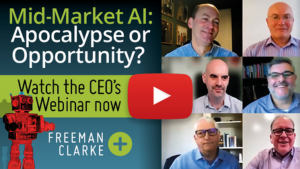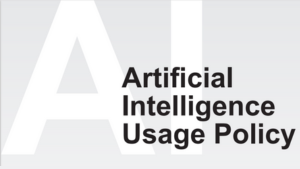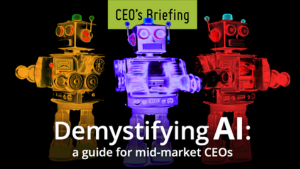Demystifying AI: Our Experts on AI and Mid-market Business
Artificial intelligence is bringing rapid change to a number of sectors and markets. But there is a simple question we haven’t seen addressed: How does a mid-market CEO identify where to implement AI? So we asked our experts. Freeman Clarke Regional Directors Andrew Hart and Gerry Lawrence have already helped dozens of mid-market businesses identify and implement AI. In this brief, informative conversation with CEO Graeme Freeman, they explain how a mid-market business leader can identify where AI can make a difference, and why it’s more accessible than you may think.
Video Transcript
Graeme Freeman: I’m talking this morning with Andy Hart and Jerry Lawrence about AI. Gentlemen, we were talking earlier about how does the chief executive of mid-market business identify opportunities to use AI to improve their business. Jerry, you have some thoughts on this.
Jerry Lawrence: I would start by looking for things in my business that are already issues I’d like to tackle, where I can see a real benefit. So, for example, if I look at say the construction industry, I see that well, gosh, there’s 30 fatalities a year in the UK, there’s 27 out of a thousand people [who] have an accident each year in the construction industry. How do we reduce that and what would the impact be on our business if we did reduce it? Using AI, you can do image scanning. You can look for people wearing hard hats automatically in a way that a human being can’t do as effectively and is much slower. So, there are certain things that are now possible that perhaps would have been challenging in the past, would have been difficult to tackle, would have maybe required a lot of people to do physical labor or manual labor or looking at screens for long, long periods of time.
GF: The security example actually is a good one, where we’ve seen plenty of cases where our Principals are using AI to process images that as you said would previously have required a control room with people looking at screens all day. That’s expensive and barely practical, whereas AI makes these things possible [more than] the way before.
JL: Indeed, and a lot of these tools are already available. So, in some cases, in many cases in fact, you don’t need to invent stuff completely from scratch. There’s software out there that already exists that uses AI in its core that will help you do this. So, on one hand, you may find that it’s just a question of going out there and looking for the right tool that exists.
Andy Hart: I think if you take that to its logical conclusion, any bulk repetitive job that you have people doing, and people are expensive right, and there’s a shortage of them. That’s probably not going to change anytime soon. How do we take that work, redeploy those people to give them something more interesting and meaningful to do, but [also] find a product or a solution that enables us to solve some of these big problems we’ve never been able to solve before. Maybe it’s in the legal sector, sorting through huge numbers of lease agreements in multiple languages. Maybe it is a safety issue. Maybe it’s predictive, so instead of using these large language models that we hear so much about in the news and in marketing these days, maybe it’s another facet of it where we’re predicting an outcome from masses of data and maybe multiple data sources, all of which would have just taken up huge amounts of people time, months to do, and now actually maybe we can have it in a few hours or a few days.
JF: It’s also the fact that size is less important for success. In fact, one could consider it to be an advantage to be smaller and more nimble, and a company that has a lot of legacy capital tied up and existing tools and processes will find it harder to transition to into these new technologies. So perhaps this is absolutely the right thing to be doing for the smaller and midsize businesses.
GF: I think that’s a really interesting point Jerry, that in some ways this kind of technology favors the mid-market business over the large business, because in many ways it reduces the value of having a gigantic complement of people. So whereas in the past only a large business could accomplish a large and complex task, that’s no longer the case, because a small business has access to artificial intelligence, rather than just large numbers of people. Okay, thank you both very much indeed.


